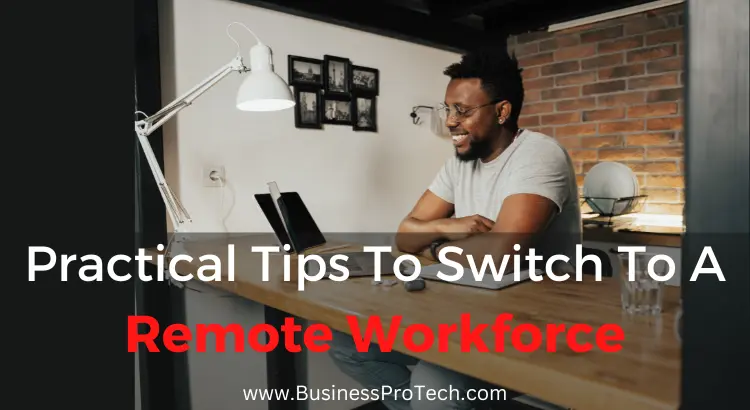Since the pandemic, remote workforces have just about taken over the corporate world. Lockdown restrictions forced businesses to find new ways of operating without risking the further spread of the virus. As a result, remote work culture erupted and quickly took over.
Not only is remote work more convenient for most employees, but it also helps businesses shave down expenses substantially. Remote work environments also prove to enhance employee productivity substantially, which is just another reason why remote work is here to stay even though the pandemic is behind us.
But beyond the benefits, there are some challenges that businesses must overcome when transitioning to a remote workforce.
So we’ve rounded up some tips to streamline the transition.

Get Everyone On The Same Page
Before you even start with the transition, it’s crucial to host a meeting with your employees to get everyone on the same page.
Each employee must understand the upcoming changes and how they will benefit the business and the team.
Rely on Couriers for Employee Equipment
Before you can move employees to a remote environment, you’ll need to have a way of getting their essential office equipment to their homes. Then there’s also the concern of terminated employee equipment pick-up.
The best solution is to rely on a delivery partner that offers remote office equipment pick-up and delivery services. The right courier service will handle equipment delivery and pick-up to ensure your team always has the essential equipment they need.
Choose A Virtual Office Space
With a remote workforce, all communication is managed on a virtual platform. But because these platforms differ dramatically, you must compare options before choosing a platform.
Virtual office spaces typically have features like answering services and remote reception, meeting and conference rooms, offices, coworking spaces, and more. And when it comes to choosing a virtual office, you’ll need to consider costs, platform features, functions, ease of use, and online reviews.
Many of these platforms offer a free version or free trial. It’s best to take advantage of these options to test the platform before choosing your team.
Also Read: Working Away from Home? Accommodation Inspirations for your SME
Encourage Casual Conversation
One of the primary challenges for remote employees is isolation. Fortunately, this concern is easy to overcome by encouraging virtual team-building activities like games nights and team get-togethers and encouraging casual conversation on a routine basis.
Team building efforts are dramatically different with a remote team, but there are many ways to ensure all your employees feel part of a team, even if they are scattered across the globe.
There are also virtual team-building companies out there that will guide you and your team toward unity. So, if you need help figuring out where to get started with team building for your remote workforce, consider reaching out to a service provider.
Check-In With Employees
No doubt, you’ll set up a reporting system, delegating system, and monitoring system to run your remote team. But beyond this, you should also check in with each employee at least once each week.
Staying in touch with your employees ensures that you are aware of how each employee is coping with workloads and various other valuable bits of information. Whether you decide to schedule a weekly virtual meeting or spend some time texting employees, keeping in touch will also help unify the team.
Set Time Expectations

When switching to a remote workforce, it’s critical to set deadlines, even if your employees have never worked with time restrictions before. Deadlines will keep employees up to date with time expectations. Moreover, employees are also more able to plan their work days when deadlines are clear.
Consider using time-tracking software to monitor project progress and stay on top of deadlines. Time-tracking software is as beneficial as virtual office spaces for remote workforces. Time tracking software also offers a few other valuable features, like online invoicing, reporting and analytics, alerts, notifications, and project management.
Test The Waters With A Hybrid Workforce
Instead of switching directly to a remote workforce, you can ease into a remote work environment by first switching to a hybrid force.
Hybrid work environments merge traditional and remote concepts; this means that employees will spend some days at the office and others working from home. While hybrid environments are most suitable for teams that need to complete some tasks at the office, the concept is also a perfect solution to transition to a remote workforce with fewer hiccups along the way.
Conclusion
Switching to a remote workforce is a great way to reduce business costs, increase productivity, and heighten employee convenience. Encouraging your employees to work from home will also reduce overhead costs significantly while saving employees travel expenses.
But it’s essential to ease into this major transition to ensure the whole team stays on track.